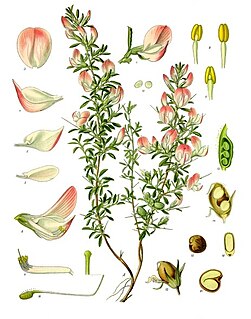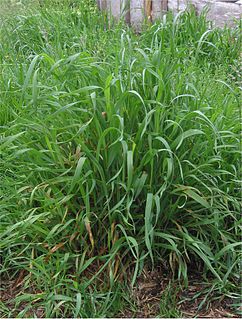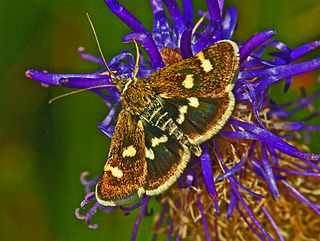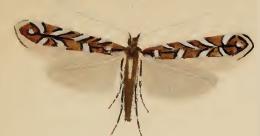
Ononis is a large genus of perennial herbs and shrubs from the legume family Fabaceae. The members of this genus are often called restharrows as some species grow as weeds on arable lands whose tough stems would stop the harrow. They are natively distributed in Europe.

Elymus repens, commonly known as couch grass, is a very common perennial species of grass native to most of Europe, Asia, the Arctic biome, and northwest Africa. It has been brought into other mild northern climates for forage or erosion control, but is often considered a weed.
Rest-harrow may refer to:

Banksia repens, the creeping banksia, is a species of shrub in the plant genus Banksia. It occurs on the south coast of Western Australia from D'Entrecasteaux National Park in the west to Mount Ragged in the east.
British NVC community MC4 is one of the maritime cliff communities in the British National Vegetation Classification system. It is one of five communities categorised as maritime cliff crevice and ledge communities.

Ononis repens or common restharrow is a plant species of the genus Ononis.

Eurrhypis pollinalis is a species of moth of the family Crambidae. It was described by Michael Denis and Ignaz Schiffermüller in 1775.

Marasmarcha lunaedactyla, also known as the crescent plume is a moth of the family Pterophoridae found in most of Europe. It was first described by Adrian Hardy Haworth in 1811.
Phyllonorycter insignitella is a moth of the family Gracillariidae. It is found in all of Europe, except the Balkan Peninsula.
Phyllonorycter medicaginella is a moth of the family Gracillariidae. It is found from Denmark and Poland to Belgium, the Alps, Bulgaria and Ukraine.

Parectopa ononidis is a moth of the family Gracillariidae. It is known from all of Europe, except Ireland and the Balkan Peninsula.

Chlorissa viridata, the small grass emerald, is a moth of the family Geometridae. The species was first described by Carl Linnaeus in his 1758 10th edition of Systema Naturae. It is found from western Europe to the eastern Palearctic.

Aproaerema anthyllidella is a moth of the family Gelechiidae. It is found in most of Europe, Kyrgyzstan, Iran and North America.

Polruan to Polperro is a coastal Site of Special Scientific Interest (SSSI) and Special Area of Conservation (SAC) in south-east Cornwall, England, UK, noted for its biological interest. It contains a wide variety of plant species and is a site for populations of breeding birds.

Zygaena hilaris is a species of moth in the family Zygaenidae.

Zygaena marcuna is a species of moth in the Zygaenidae family. It is found in Morocco, Algeria and Tunisia. It is dull red or dark pink. The black dot situated in the distal area touches the black costal margin, and the red basal area is separated from the red discal area by a heavy black band. It was described from the Aures Mountains from specimens found in May.The larval host plants are Ononis natrix and Ononis repens. Imagines fly in May and June.
Bembecia albanensis is a moth of the family Sesiidae. It is found from most of Europe to Asia Minor and the Black Sea. It is also found in North Africa.

Calocoris roseomaculatus is a species of bugs in the Mirinae subfamily of the Miridae family.

West's Meadow, Aldermaston is a 1.2-hectare (3.0-acre) biological Site of Special Scientific Interest south of Aldermaston in Berkshire.

Westfield Farm Chalk Bank is a 14.1-hectare (35-acre) biological Site of Special Scientific Interest west of East Garston in Berkshire.














